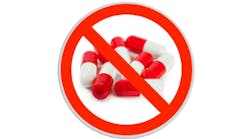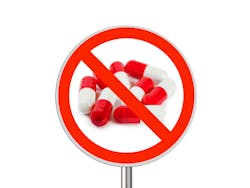Fighting the epidemic: My experience with an opioid-free practice
Dr. Desirée Walker still remembers the reactions from the group of health-care providers, who were gathered to discuss the opioid epidemic and substance abuse, when she said that she has an opioid-free practice. Silence. And then: Can you repeat that, please? She explains the opioid-free protocol that has worked well in her practice for two years. And yes, she still provides the same surgical procedures, but without prescribing opioids.
Editor's note: This article first appeared in Breakthrough Clinical, the clinical specialties newsletter created just for dentists. Browse our newsletter archives to find out more and subscribe here.
I remember the moment when jaws dropped and eyes widened. What followed was silence from those participating in the discussion as they processed the words I had just said. I was asked to repeat my statement to the group of physicians, dentists, and other health-care providers who had gathered to discuss substance abuse in my rural community.
"I HAVE A NARCOTIC-/OPIOID-FREE PRACTICE," I said.
This time, there was no misunderstanding. My colleagues were dumbfounded by what they had just heard me say, and they were in awe of the bold direction I had taken in this action-driven stance.
Processing my words was the catalyst to many questions. What if a patient demands a medication? What if a patient gets upset and threatens to leave your practice? What if you get labeled as being insensitive to patients' needs? You could quickly see the fear in the eyes of some of the other providers who said they did not believe it was possible to achieve this.
I have had a narcotic-/opioid-free practice for more than two years. I still provide the same surgical procedures (e.g., extractions, bone grafts, ridge preservation, etc.), but I have stopped prescribing Tylenol III, Vicodin, and a myriad of other opioids based on research guidelines. To be clear, my decision is based on published evidence and personal experience.
According to Moore et al. (2018), the NSAIDs are more effective for severe oral pain and present the least risk of long-term harm. (1) Furthermore, the combination of acetaminophen and NSAIDs may be an even better option to treat acute oral pain. (2) The American Dental Association also has a great resource guide on its website for helping combat opioid abuse. (3)
So, how is this approach conducted at my practice, Lumber River Dental? Following is a list of considerations I have found that work well. Keep in mind that some of these might need to be tweaked depending on the practice and location.
The do’s and don’ts
I have found this combination to be effective: 400 mg to 600 mg of ibuprofen with 1000 mg of acetaminophen every eight hours—with heavy emphasis on the recommended maximum ibuprofen (2400 mg to 3200 mg) and acetaminophen (3000 mg). However, you need to have a strategy to set yourself up for success. This approach will likely not work well if you are cavalier in how you deliver the message. For example, I do not say, “I extracted your tooth, and you might have some pain. I suggest taking some ibuprofen and acetaminophen if this happens." This approach is not likely to be well-received by patients. Effective communication is key.
Write an Rx
I know what you may be thinking—you can get ibuprofen and acetaminophen over-the-counter, so why is it necessary to write a prescription? In my experience, writing a prescription helps with patient compliance, because it lists details of the medication protocol. The written prescription also allows patients to leave with something tangible in hand. At that point, it is irrelevant that the prescription is only for over-the-counter medication. Leaving with a prescription has a powerful psychological effect and can offer financial savings for patients as well.
Patient education, verbal and written instructions
Every patient in my practice who receives this protocol also receives verbal and written instructions about how to take the medication. In my experience, verbal and written instructions as a combination work better than verbal instructions alone. Taking time to verbally explain the protocol to the patient allows for a little more doctor-patient face time, which helps establish a trusting relationship. We refer to the combination of ibuprofen and acetaminophen as a medication sandwich to drive home the importance of combining the two medications. The verbal message may sound similar to the following: (Please note the “Dr. Walker” would be replaced with “I” if I were giving the instructions rather than my dental assistant.)
For your comfort during the healing process, it is important that you take the medication just as Dr. Walker has prescribed. It is a medication sandwich of ibuprofen and acetaminophen. Dr. Walker has prescribed your specific dose of ibuprofen, which you will get filled at the pharmacy. You will take it with [specific dose which includes the number of tablets and total milligrams] of Tylenol. You will take it x times a day and approximately x hours apart. Remember, it is important that you follow these directions specifically for the medication to work as effectively as possible. What questions do you have?
Then, we provide the patient with the written prescription and instructions that restate the medication sandwich combination, specific dosages, time intervals, and number of tablets (for acetaminophen). We also list the practice phone number and my personal cell phone number in case the patient has questions or after-hours concerns. If a patient calls or texts, which is rare, we email or text the patient these instructions again.
Follow-up
On follow-up calls, I specifically ask patients how well they have tolerated the medication sandwich and how they have been taking the medications. Asking them to repeat the medication sandwich instructions allows me to assess how well they have complied with the protocol. It also allows me to assess if they have had any adverse reactions.
Lumber River Dental results
You might be wondering how all of this has worked out for me and my practice. Did the fears of my colleagues at the substance-abuse meeting come to light? Did patients become raving mad, issue threats, and call me nonstop on my cell phone? In short, no. Since implementing this protocol, I have had four patients to date ask for stronger medication. I gently informed them that the medication sandwich is the strongest and most effective for their dental pain and is supported by research. Additionally, I also let them know that this protocol is the best for their body and overall health.
For patients who have ibuprofen contraindications, pain control may be acetaminophen only. For those receiving pain management care from a physician, I coordinate medication therapy with the patient’s physician on a case-by-case basis.
One of my biggest and welcomed surprises was that my patients have received no adverse reactions with this protocol. Although I provide my patients with my personal cell phone number, I rarely get calls from patients needing my help. I also have not received texts or calls from patients saying they have experienced side effects from narcotic/opioid medications. I cannot emphasize this enough: The ibuprofen and acetaminophen protocol has significantly decreased my post-op and still-in-pain emergency visits. Overall, this a big win for the patient, dentist, and practice.
Do not let fear of what-ifs keep you from taking a similar approach. This protocol has served my patients well and eliminated an average of four calls per month due to side effects of narcotic/opioid prescriptions. I also take comfort in knowing I am helping to fight the epidemic of narcotic/opioid abuse in my community. My hope is that my story will inspire you to examine the narcotic/opioid prescription protocols in your practice.
References
1. Prescription opioid abuse. American Dental Association website. https://www.ada.org/en/advocacy/advocacy-issues/prescription-opioid-abuse?utm_medium=VanityUrl. Updated August 9, 2018.
2. Moore PA, Hersh EV. Combining ibuprofen and acetaminophen for acute pain management after third-molar extractions: translating clinical research to dental practice. J Am Dent Assoc. 2013;144(8):898-908.
3. Moore PA, Ziegler KM, Lipman RD, Aminoshariae A, Carrasco-Labra A, Mariotti A. Benefits and harms associated with analgesic medications used in the management of acute dental pain: an overview of systematic reviews. J Am Dent Assoc. 2018;149(4):256-265.e3. doi: 10.1016/j.adaj.2018.02.012.
Editor's note: This article first appeared in Breakthrough Clinical, the clinical specialties newsletter created just for dentists. Browse our newsletter archives to find out more and subscribe here.


